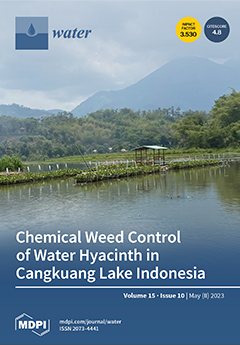Fluoride (F) is an essential element of drinking water for human health, especially for bone development and enamel creation. However, if the fluoride content in drinking water is higher than 1.5 mg/L or lower than 0.5 mg/L, it will cause endemic diseases, such
[...] Read more.
Fluoride (F) is an essential element of drinking water for human health, especially for bone development and enamel creation. However, if the fluoride content in drinking water is higher than 1.5 mg/L or lower than 0.5 mg/L, it will cause endemic diseases, such as dental fluorosis. There are two main hydrogeological characteristics: the properties of the water-bearing rocks and groundwater conditions controlled the groundwater in guide basin. The geothermal water can be divided into fracture convection and sedimentary basin geothermal water according to its geological environment and heat transfer mode. Inductively coupled plasma spectrometry is a significant tool for groundwater quality analysis. The geochemical factors of fluoride enrichment in confined geothermal water mainly include pH, ion exchange, and mineral saturation. Both groundwater samples are slightly alkaline, while the phreatic water and surface water record pH values of 8.5, 7.78, and 7.8, respectively. The salinity of groundwater water is not high, but for confined geothermal water, phreatic water, and surface water measures 706.0, 430.1 and 285.9 mg/L respectively. The higher the pH of groundwater, the more beneficial it is to the enrichment of fluoride. In contrast, the main cations in phreatic water and surface water are calcium ions and magnesium ions. The anions in groundwater and surface water mainly include SO
42− and HCO
3−, followed by Cl
−, indicating that the groundwater and surface water here is mainly leaching. Fluoride was shown to be positively correlated with sodium and bicarbonate. Moreover, the results indicate that F
− enrichment is usually associated with high HCO
3− and Na
+ concentrations in water, while a high Ca
2+ concentration tends to lower the F
− concentration in water. This means that the ion exchange between calcium ions and sodium ions may lead to fluoride enrichment in natural water. As mentioned above, high-sodium and low-calcium water are favorable for fluoride enrichment. Moreover, saturation indices of fluorite, gypsum, dolomite, and calcite, as well as the saturation index of fluorite, represent a vital method to understand the fluoride enrichment. According to this study, fluoride as a pollutant poses great risks to human health overall, whether lower than or higher than the drinking water limit. Children face higher health risks than adults caused by confined geothermal water drinking intake. This study suggests that groundwater treatment should be conducted to reduce fluoride concentration in drinking water. It is suggested that when confined geothermal water is used as drinking water, it should be mixed with phreatic water and surface water in a certain proportion to make the fluoride in groundwater reach the range of safe drinking water.
Full article





